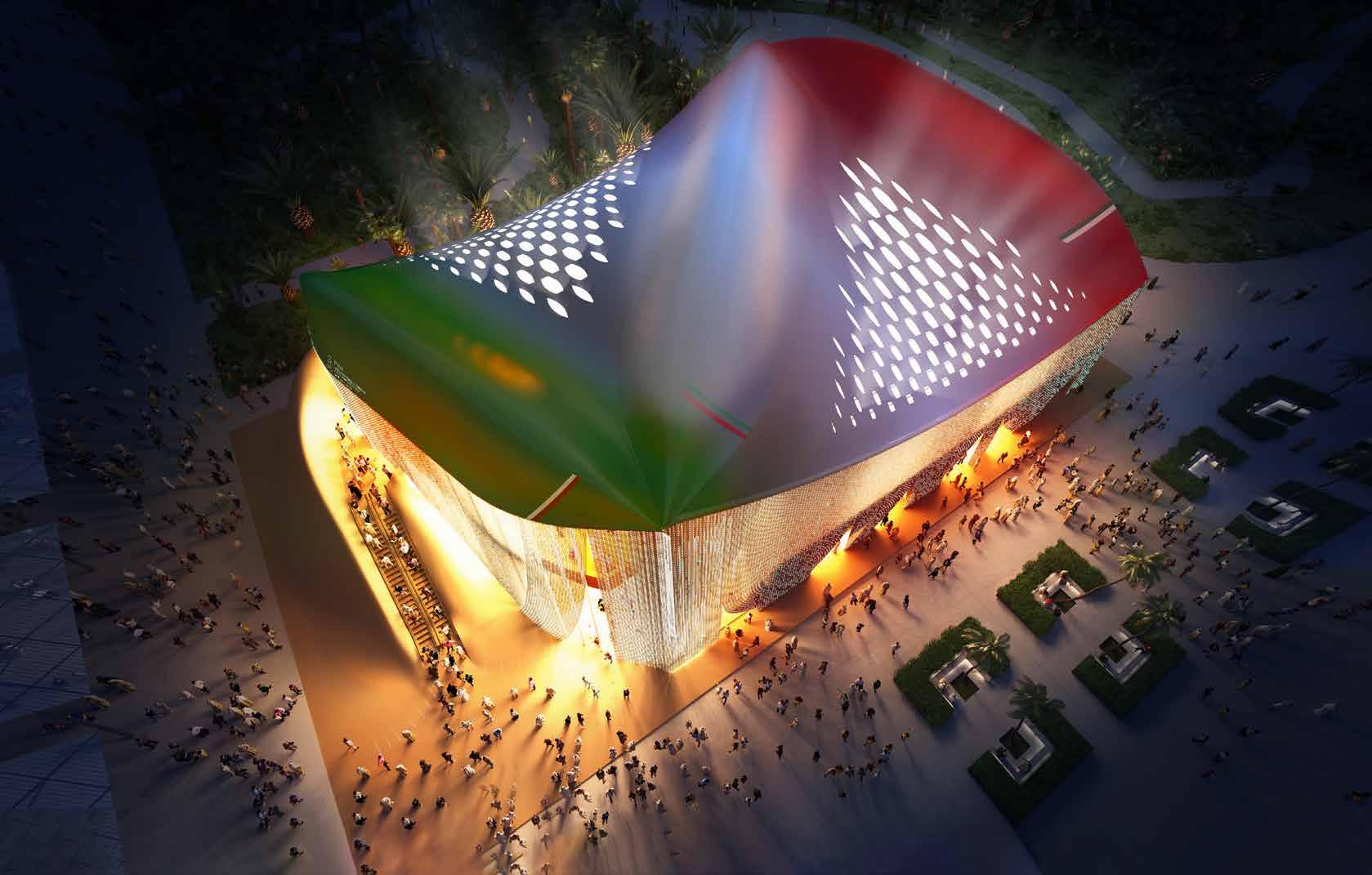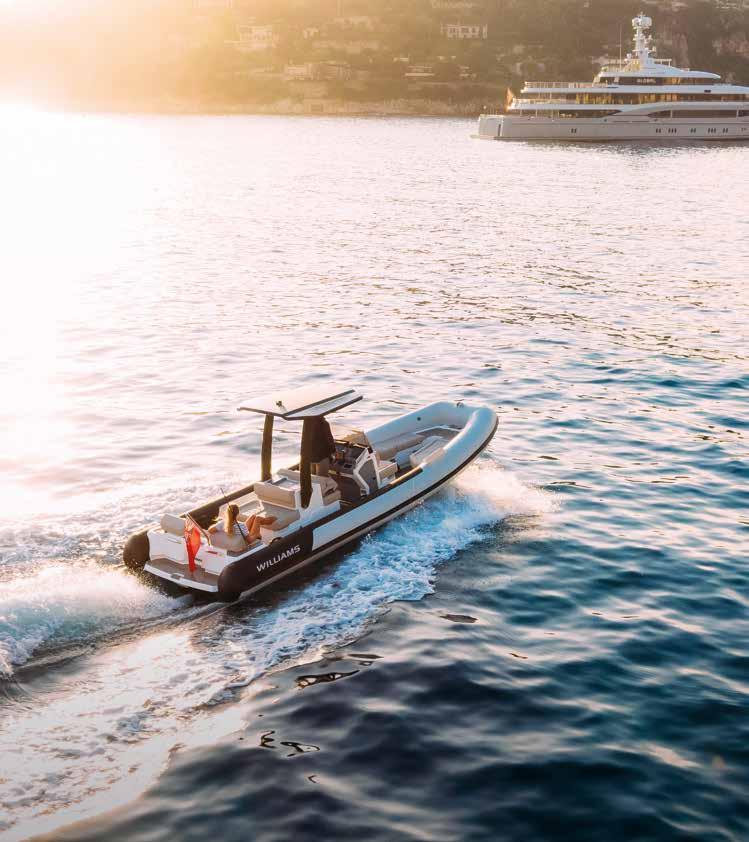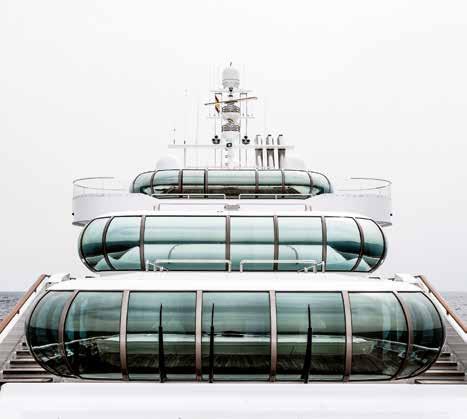
10 minute read
Keeping pace in the space race
A report on the optimisation of on-board space
BY MAX STOTT
As superyachts increase in size, the industry must retain its responsibility to ensure every square metre of space is optimised.
There’s no right answer to the question of how to allocate space on a superyacht. It’s the result of a symbiotic relationship between ship builder and superyacht owner. However, over the years, it has become increasingly the norm to accept that it’s rare to see an owner enjoying their lavish owner’s deck or for a complex balcony installation to take its fully extended form. Far too often, a dining room, sauna or beach club is used for storage instead of for its original purpose.
Wasted space is seen mostly on superyachts for new owners. However, this is not solely due to their lack of experience; there’s also a significant disparity between owner, captain and builder. When we asked one captain whether he thought designers had an obligation to pass on their common experience about what constitutes onboard enjoyment, he replied with a chuckle, “It’s an interesting question because it works on the presumption that designers know what it’s like on board a superyacht.”
The goal of optimising space can be reached through a number of routes. The use of 3D renderings and VR can help to eliminate human error in the build process. Hybrid engines, depending on the type, are also reducing the size of engine rooms and freeing up space for the owner and crew. Designers and ship builders are also taking into consideration the full life cycle of a superyacht to ensure refit and repair work is more sustainable and cost-effective. But also, as we are seeing more often, the parameters that limit the fundamental ‘laws’ of design are being constantly pushed further.
For experienced owners who know exactly what they want, space is almost never wasted and is often optimised. Mexican businessman Emilio Azcarraga, who owned Paraiso and Azteca before he
The stateroom on board M/Y Zeus was built a level higher than the bridge.
© Guillaume Plisson decided to build M/Y ECO (now Zeus) in 1989, changed one of the most rigid boat design laws in the industry. On Zeus, the owner’s stateroom is a floor above the bridge. When the designer suggested the top floor would be more suitable for the captain because there is less spray and a better view, Azcarraga replied, “Yes, that’s why I’m there.”
To this day, the owner’s cabin on Zeus remains above the bridge and serves as an example of how the necessity of client satisfaction can trump the rigid parameters of boat design. Azcarraga was an owner who used his superyacht experience and love of yachting to craft a vessel that he knew he could get the most out of.
In the 1970s and 1980s, when the largest private vessels were a quarter of the size of the current largest superyacht, wasted space was not seen as an issue. Many crewmembers who worked on superyachts in earlier decades reported that every inch of the superyacht was used by the owner. The reason for this could just be because superyachts were smaller then, but with the evolution of design and technology moving at such an unprecedented pace, it’s difficult to resist the urge of taking a step back and observing with a critical eye.
Legendary designer Jon Bannenberg advocated practicality and simplicity throughout his celebrated career. In 2002, just before Lürssen launched 97m Carinthia, Bannenberg admitted his inspiration derived from the minimalist and simplistic silhouettes of the naval vessels in the Lürssen shipyard. At Lürssen’s 125th birthday in 2000, he said, “I could see how structures were driven only by the need to support the purpose for which they were designed.”
Optimising space is obviously not something exclusive to megayachts; designers in the 25-45m bracket have been addressing this issue at an
Below: Space optimisation was at the forefront of the design process on the Princess X Class. Bottom: Project Fury is a concept that features 40 per cent more space than sail boats of a comparative length.
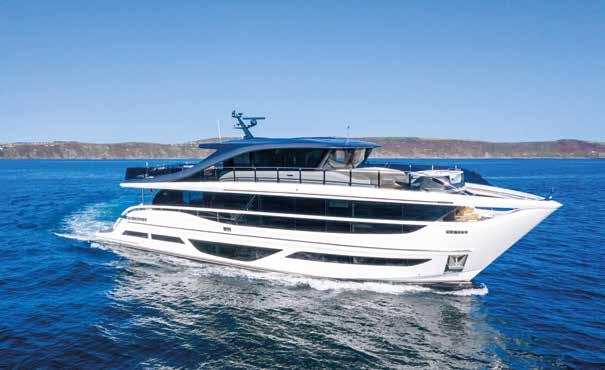
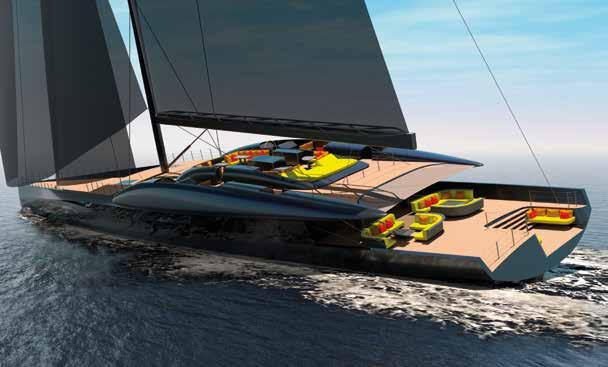
Image: Van Geest Design and Rob Doyle Design
increasing rate in recent years. The Princess X Class, The San Lorenzo X-Space and the Wally Why200 are just a few of the prime examples of this. In this size range, the optimisation of space is more evident in every nook and cranny of the superyacht.
However, the 50m-plus bracket is where things get more interesting, according to Pieter van Geest, of Van Geest Design. “Most designers will tell you that an 80-metre superyacht is the ideal size because you can include all the most desirable features in a comfortable space. With 50-metre boats, the client often wants all those same features that you find in an 80-metre, so that’s where things get a bit more tricky.”
Van Geest, along with Rob Doyle, of Rob Doyle Design, recently delivered a very well received 63m sailing yacht concept named Project Fury. The sailing yacht boasts 705gt – a 40 per cent increase in space compared to most sailing vessels of the same length.
Project Fury effectively features the interior of a motoryacht inside a sail boat. “There were no real main challenges. It’s almost as if nobody ever came up with it,” explains Van Geest. “It’s weird because when you put it all together, it makes so much sense.” The simplicity of the concept, when studied alongside the impact of the final result, almost demands credit to the designers responsible.
Today, there is a vast expanse of concept superyachts circulating in the media space. Many of the most viral concepts, while they must be applauded for their passionate nature, are often unachievable. On the other hand, there are a number of ‘conceptual concepts’ that are innovative in their own right but fail to offer anything ground-breaking. What Van Geest and Doyle have delivered in Project Fury is a superyacht that sits in the very heart of this spectrum.
Van Geest also offers his thoughts on the allocation of space on larger superyachts. “I think that space optimisers are usually people who started from small boats going into big boats. Big-boat designers, I don’t think they are in a position to optimise space.”
The Amsterdam-based designer, who is currently designing a 90m superyacht, adds, “You have to ask yourself, are you optimising space or are you just using it? We have created a design with so much space that we are currently deciding what we are going to do with it. It sounds shocking, but with the larger yachts you have to be really creative in what you do and how you do it. How many swimming pools and hot tubs can you have at the end of the day?”
One aspect that appears to be a particular gripe for stakeholders in the industry are the ‘design gimmicks’ that appear to be more and more frequent. Christoph Schaefer, who has been a captain on superyachts for more than three decades, says, “I’m always a little bit disappointed by what they do, what they call innovation. They put a lot of gimmicks on which are meant to enhance the owner’s experience, but on one boat I worked on, the dining salon was used once the entire time and that was it. Why bother with it? Why don’t we start rethinking things a little bit?
“True innovation, when it comes to the bridge, when it comes to navigation, when it comes to hybrid installations in the engine room, that is always driven by really experienced owners who are well past the gimmick stage. They might include gimmicks just because they know the resale value of the boat later on is going to be higher.”
Of the ‘gimmicks’ that Schaefer refers to, he highlights a few from his own experience that were eventually deemed a waste of space. “We had the owner’s balcony in the master stateroom. This was a feature that was used quite a bit in the beginning, and then less and less towards the end until it was basically never really used anymore at all.”
An unused feature not only takes up space, it also takes up working hours. “There was this barbecue pit made out of stainless steel. The crew spent hundreds of hours polishing it and it was never used once,” says Schaefer. Over-complicated electric and hydraulic designs have also proved to be something of
A dining table, dance floor and cinema all in the same space.

a headache for Schaefer’s crew in the past. “We had these hydraulic falling bulwarks and sliding doors that meant the dining salon could be completely opened up. In the end, the crew didn’t operate it anymore because we just had constant problems with the electrics and hydraulics that didn’t work. It was just too overcomplicated.”
Kate Hadjidimos, of D-ID design studio, explains how she has tackled the issue of wasted space on superyachts through exploring multi-functionality. “Something we did recently was focus on addressing this issue of how much space is not used on a yacht or is used in such a small capacity,” she says.
“If you monitor the percentage of what rooms are used at what times of the day, you will see that the dining room is one of the areas that really flags up. So we have created different opportunities for that space with technology, and what that translates to is a standard configuration of 10 seats around the table which can be extended to seat 16. But, crucially, it can also all be packed away with the storage, all planned within the space, so the area can be transformed into a full-set cinema or a dance club.”
A superyacht is a complicated space; on the one hand, it demands comfort and relaxation for the owner while on the other, it must provide practicality in conjunction with the labour-intensive tasks of the crewmembers. Hadjidimos highlights the importance of considering the crew areas on board a superyacht when allocating space. “It’s intensive work, and at times the crew need to be seen and at other times they don’t. If they are changing bags and moving dirty linen around, they don’t want to operate in public and the guests on board don’t
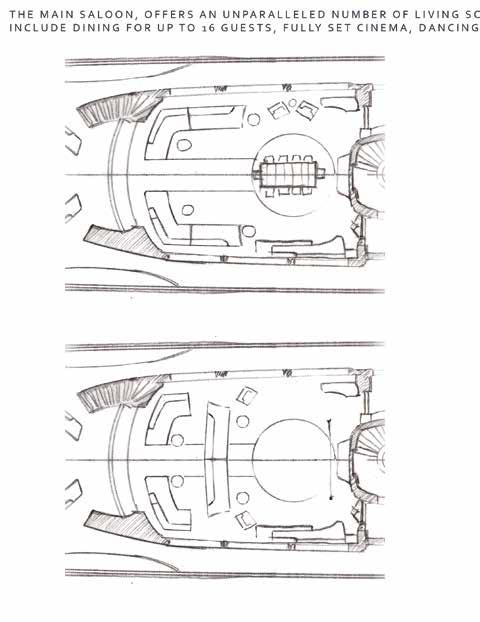
© 2021 D-iD Ltd


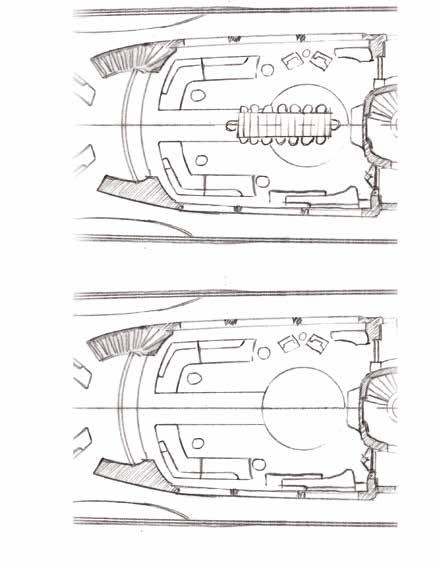
want to witness these efforts either. So crew circulation is always an important part of our consideration.
“If the crew are happy on board, then the chances are much higher the client is happy on board. As a designer, your foremost aim is for the client to be happy. To ignore the crew areas and solely focus on making the owner’s area beautiful and decorative without addressing the practical side of things, then I think from a design perspective, that’s a missed opportunity.”
Hadjidimos believes that the next generation of superyacht owners will be the biggest driving force for future innovation in superyacht design, “Specifically clients who are new to yachting, who’ve got experience in other industries. Their requests and ideas will push the boundaries of yacht design.”
Meanwhile, Van Geest is particularly enthusiastic about the emergence of digital tools coming in to play. “Virtual reality and 3D rendering is going to be standard in the next two or three years and it’s going to really help the process of shipbuilding.”
There’s a bubbling sense of excitement and anticipation in the superyacht design world. When analysing some of the more ostentatious and unpractical design gimmicks that remain in the industry, there’s a sense that you are observing the landscape through a rear-view mirror. That said, if you are to analyse the present and future prospects of space optimisation on superyachts, you’ll find that your cynicism is quickly replaced by optimism. MS
DO YOU WANT TO KNOW MORE? VISIT SUPERYACHTNEWS.COM AND SEARCH ‘LAYOUT’
